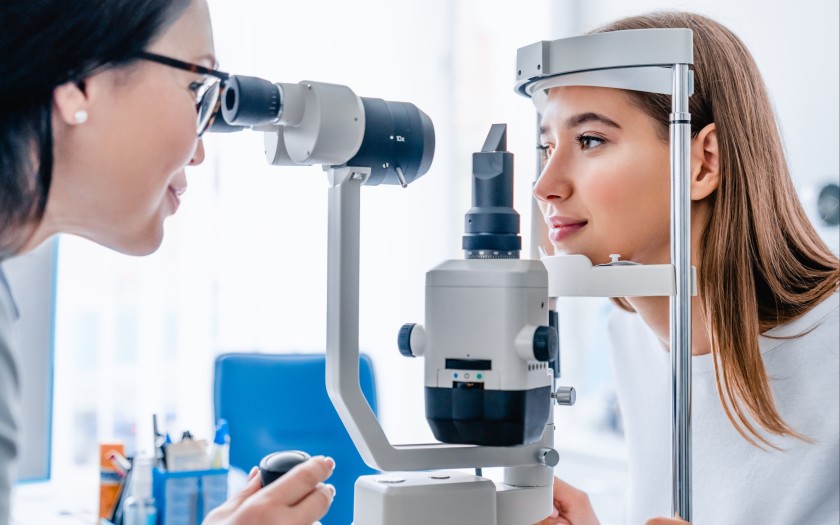Buy one pair of eyeglasses, get a second pair 50% off!
*Restrictions apply. Click here for details.

The Difference Between Standard Vision Screenings and a Comprehensive Eye Exam
You may have thought your latest vision screening told you the whole story about your eye health, but an eye screening is not the same as a comprehensive eye exam.
Vision screenings are not a replacement for a complete eye exam by an eye care professional. Comprehensive eye exams are critical for understanding and acting on your overall health.
In this article, we examine the differences between these two tests, including why a screening isn't a substitute for a comprehensive eye exam and when you should have a full eye exam.
What is a standard vision screening?
Also called an eye test or a vision test, this short exam identifies vision problems and eye disorders, but — and this is key — a vision screening is not meant to diagnose or treat those issues. Instead, it's meant to find people who might have eye problems, so they can then see an eye doctor for a comprehensive eye exam.
This standard screening tool is commonly used in children at schools or pediatricians' offices to identify eye conditions. This screening can detect issues including lazy eye (also known by its medical term, amblyopia) and crossed eyes (or strabismus). When found early, treatment for these eye conditions may prevent vision loss.
While routine screenings aren't usually recommended in adults, vision tests that determine how well you see (or your visual acuity) are common in the U.S. for obtaining a driver's license. These tests are often given at the DMV and are performed when your license is issued or reissued. You might also encounter eye screenings at your primary care doctor's office or health events held by hospitals or community groups. Just as with kids, these screenings are meant to identify problems but not diagnose or treat them.
What do they test for in a standard vision screening?
Vision screenings can include different types of exams, such as one or more of the following:
Close-up vision test: This test can be given to both children and adults but is often given to people who are 40 or older to determine if their close-up vision is worsening.
Color blindness test: Given to both children and adults, this test can help determine if a person is colorblind.
Visual acuity test: This can be given to children and adults and helps determine their distance vision.
Visual acuity test for preschoolers: This is just like the regular distance vision test but adjusted for non-readers.
What is a comprehensive eye exam?
Comprehensive eye exams are vision screening tests performed at your eye doctor's office. These exams are vital because they can help find medical problems that have no signs or symptoms, eye-related or not. Comprehensive eye exams can find early warning signs of some 270 systemic and chronic diseases, including heart disease, cancers, and diabetes.
The sooner these conditions are diagnosed, the better your treatment and recovery odds. They can also catch eye diseases early, too, like glaucoma, diabetic retinopathy, and age-related macular degeneration (AMD). By detecting these conditions early, your eye doctor can help prevent blindness.
A dilated exam can detect conditions that are not related to the eyes because dilation allows your doctor to see key blood vessels and the optic nerve. These connect the eye to the brain. By seeing these things, your doctor can visualize issues that can have telling first signs in the eye.
What do eye doctors test for in a comprehensive eye exam?
During a comprehensive eye exam, your eye doctor might do all (or some) of the following:
Take your medical history. Your doctor will want to know about your vision and health, including your family medical history, any medications you use, and if you have corrective lenses.
Measure your visual acuity. Your eye doctor will use an eye chart to determine how well you see. These tests often utilize the Snellen chart, the familiar, standard eye chart you might have seen at school nurses' or doctors’ offices. The Snellen chart contains big and little letters arranged in rows or columns, which helps eye care professionals determine how well you see letters and shapes.
Examine all parts of the eye and its mobility. This might include looking at specific aspects of your eye health and visual function. Your eye doctor will utilize a slit lamp microscope to examine your eyes (and even eyelids). Dilating eye drops will help your doctor see into your eye for any signs of disease.
Use other tools. Depending on your individual eye health needs, your doctor might use other tests to determine if you have other eye problems.
Essentially, a vision screening isn't enough to take care of either your eyes or vision. Schedule a state-of-the-art, comprehensive eye exam by eyecarecenter today for the full benefit of an eye doctor checking your sight.
Find an eyecarecenter location and book your appointment today!
